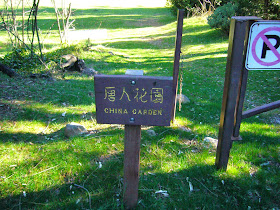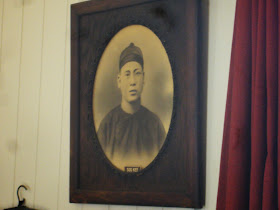 |
| Katie Amaral (right) of Dave Wilson Nursery |
There she is. To your right. That, my friends, is Miss Katie Amaral. And that is your's truly to the left of Katie. This photo was snapped about two weeks ago. For the people that I work with day in and day out at the California State Capitol, you might recognize this as the entry room to the Governor's Office on the first floor of the State Capitol Annex.
That's where I would find Katie Amaral on this fine day. And, although we've known each other for years, this was the first time we actually met in person. Katie and I have been corresponding with one another via email for years. Oh -- nothing to worry about. Nothing insidious here. Yes, the wife that is Venus knows all about Miss Katie. As it turns out -- all three of us share a love for fruit trees.
And, if you love fruit trees as much as we do, Katie happens to hold down the dream job of Marketing Manager for Dave Wilson Nursery in Hickman, CA. They just happen to be the largest provider of fruit trees on the planet. Want to parlay about pluots? Talk to Katie. In pursuit of peaches? You need to see Katie. Compare notes about Nectaplums? See Katie Amaral.
 |
| Mark Stromberg |
Katie's visit came at an opportune time. That was a rather tough week two weeks ago when this photo was taken. It's been a rough couple of weeks since then. I suppose this reaction is quite normal when a brother-in-law suddenly and surprisingly passes away. And that's exactly what Mark Stromberg did on March 12th. He had just turned 42 years old. He died from triple organ failure.
I know what you're probably thinking. How does an otherwise healthy 42-year old man suddenly and unexpectedly pass from triple organ failure? It's the same question the family is asking. You see, we don't know. We're not doctors. But we are hoping the Sacramento County Coroner can find the answer. Yet -- these types of investigations take time. Autopsy results are still pending.
 |
| Venus and Barky |
I still don't know how Venus has managed to maintain the strength she has. She was the first one with her brother when they brought him into the Sutter General emergency room, very much unresponsive. Although I would join her later as we sat outside the room Mark was in, there wasn't much we could do other than hold one another after Mark's heart stopped beating again and again. We could hear the monitor code. We saw emergency room physicians and nurses rushing in and out. There was little else we could do.
The wife that is Venus is now the last surviving member of a family of four. She lost both her mother and father to cancer. And now she's lost her baby brother -- Barky she would sometimes call him. Somehow she has to deal with his. The only thing I can do at this point is be here to support her, in whatever she may need.
So you can imagine how I felt that day when Katie Amaral messaged me to say she was in the Governor's Office. I couldn't get out of my State Senate chair quickly enough. I needed the distraction from the thoughts going through my mind about my brother-in-law and how things could have gone so horribly wrong. Katie offered that distraction -- and I can't thank her enough for it.
 |
| Backyard Orchard Culture Pear Trees |
You see, Katie is responsible for many of the fruit trees growing in the Bird Back 40. There wouldn't be a five-in-one Pride Peach Collection without her help. The Harrow Delight and Blake's Pride pear trees also found their way into a raised bed thanks to her efforts.
To be honest -- I haven't felt like doing a whole lot since Mark's passing. Working in the yard does provide some relief, but it's just an escape from the reality of this thing called life. At some point I have to get back to living life. That's been a tough assignment. How can I possibly blog about heirloom tomatoes when this is hanging over my head?
 |
| Celina Marie and Marquitos Stromberg |
Mark leaves behind a wife and two children. Our niece and nephew now have to face the reality of growing up without a father. That's not easy. I remember how I felt when my mother told me that my father had passed away in the hospital. I was nine years old. I grew up without a father. You can grow up without one. I'm living proof of that. But it was anything but easy.
Perhaps that is the answer then? Be there for the kids? We can't be a father to them, but we can sure do everything we possibly can to be the best and most attentive uncle and aunt (or Tio and Tia). I suppose that is the answer then. Be strong for the children. Be strong because strength and mentoring is what they need the most right now.
It isn't easy. But we're up to the task. So long, Mark Stromberg. And thanks for the visit, Katie Amaral. It came at an opportune time.



























